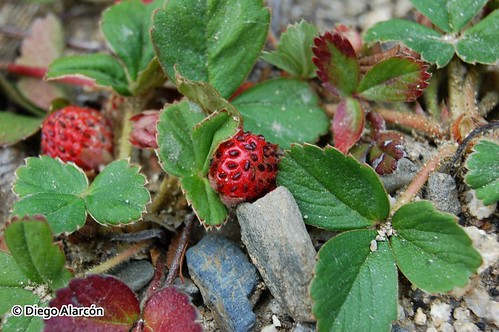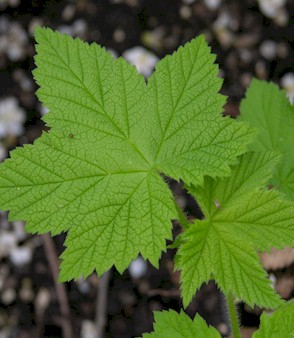Latin Name: Acer circinatum
Common Name: vine maple
Family: Sapindaceae
Origin: SW BC to Northern California
Tree/Shrub/Herb: Deciduous shrub
Form: Upright, round in sun or reaching for light in shade
Habit: Multi-stemmed from base
Buds: Opposite
Leaves: Palmately lobed, 7-11 lobes, coarsely toothed
Flowers: Red calyx, 5 greenish-yellow petals
Fruit: Schizocarp
Stem/Bark: Relatively smooth, greenish-grey colour
Cultural Requirements: Moist organic soil, full sun to woodland shade
Landscape Uses: Small garden "tree"
Notes: Specimens up to 18m tall have been found in the wild
Latin Name: Acer macrophyllum
Common Name: bigleaf maple
Family: Sapindaceae
Origin: Coast of Western North America
Tree/Shrub/Herb: Deciduous tree
Form: Upright, singular
Habit: Arching secondary branching, irregular
Buds: Opposite
Leaves: Largest of all maples, 15-30cm across, 5 lobes
Flowers: Yellowish-green pendulous racemes
Fruit: Schizocarps
Stem/Bark: Greyish brown bark
Cultural Requirements: Moist organic soil, full sun to woodland shade
Landscape Uses: Only to be used in parks or on very large properties
Notes: Commonly 15-20m tall, often fosters epiphytes
Latin Name: Arbutus menziesii
Common Name: pacific madrone
Family: Ericaceae
Origin: Coastal Pacific North America
Tree/Shrub/Herb: Broadleaf evergreen tree
Form: Upright, bending towards light
Habit: Multi branched, irregular twisted branches
Buds: Spirally arranged
Leaves: Thick, waxy, oval, 7-15cm long
Flowers: Bell-like flowers
Fruit: Red berries
Stem/Bark: Rediish bark that peels
Cultural Requirements: Sunny well drained site, these trees don't transplant well
Landscape Uses: Park or large garden
Notes: Berries were traditionally used for medicinal purposes
Latin Name: Arctostaphylos columbiana
Common Name: hairy manzanita
Family: Ericaceae
Origin: Western North America
Tree/Shrub/Herb: Evergreen shrub
Form: Upright, rounded
Habit: Twisted, spreading branching
Buds: Alternate
Leaves: Simple, ovate, pointed apex, tomentose
Flowers: Racemes of whitish-pink urn shaped florets
Fruit: Blackish-red berries
Stem/Bark: Purplish-red bark
Cultural Requirements: Full sun, well drained soil, drought tolerant, needs good air flow
Landscape Uses: Interesting specimen shrub
Notes: This plant is considered a weed on Christmas tree farms
Latin Name: Arctostaphylos uva-ursi
Common Name: kinnikinnick
Family: Ericaceae
Origin: Circumpolar (Northern hemisphere)
Tree/Shrub/Herb: Evergreen shrub
Form: Low, matlike
Habit: Spreading
Buds: Alternate
Leaves: Simple, leathery, small, obovate, rounded apex
Flowers: Terminal clusters of pinkish urn shaped flowers
Fruit: Red berries
Stem/Bark: Brown woody old growth, slightly reddish new growth
Cultural Requirements: Average, well drained soil in full sun to partial shade
Landscape Uses: Groundcover, but not in high traffic areas due to mechanical damage
Notes: Flowers bloom from May to June
Latin Name: Athyrium filix-femina
Common Name: lady fern
Family: Dryopteridaceae
Origin: Temperate Northern hemisphere
Tree/Shrub/Herb: Fern
Form: Low, arching
Habit: Spreading branches from central area
Buds: Basal
Leaves: Bi-pinnately divided, pinnae lanceolate
Cultural Requirements: Partial to full shade, rich organic, well-drained, moist soil
Landscape Uses: Texture amongst other plantings
Notes: Reproductive structures with sori are inconspicuous, thus held in a "lady-like" manner which is how the common name arose
Latin Name: Berberis aquifolium
Common Name: tall Oregon grape
Family: Berberidaceae
Origin: Western North America
Tree/Shrub/Herb: Evergreen shrub
Form: Upright, tall compared to nervosa and repens
Habit: Horizontal branching from upright stems
Buds: Alternate
Leaves: Pinnately compound, spiny leaflets
Flowers: Racemes of yellow flowers
Fruit: Dark blue berries
Stem/Bark: Brownish woody stems
Cultural Requirements: Drought resistant, lean soil, semi-shade
Landscape Uses: Garden shrub
Notes: Has been considered invasive outside of its native range
Latin Name: Berberis nervosa
Common Name: dull Oregon grape
Family: Berberidaceae
Origin: Western North America
Tree/Shrub/Herb: Evergreen shrub
Form: Low, dense
Habit: Arching, spreading
Buds: Alternate
Leaves: Pinnately compound, spiny leaflets, pointier leaflets than repens, less shiny than aquilfolium
Flowers: Racemes of yellow flowers
Fruit: Dark blue berries
Stem/Bark: Brownish woody stems
Cultural Requirements: Drought resistant, lean soil, semi-shade
Landscape Uses: Low shrubby winter interest
Notes: Fruit is bitter tasting
Latin Name: Berberis repens
Common Name: creeping Oregon grape
Family: Berberidaceae
Origin: Western North America
Tree/Shrub/Herb: Evergreen shrub
Form: Low, dense
Habit: Arching, spreading
Buds: Alternate
Leaves: Pinnately compound, spiny leaflets, more rounded leaflet than nervosa
Flowers: Racemes of yellow flowers
Fruit: Dark blue berries
Stem/Bark: Brownish woody stems
Cultural Requirements: Drought resistant, lean soil, semi-shade
Landscape Uses: Low shrubby winter interest
Notes: Found as far south as Mexico
Latin Name: Blechnum spicant
Common Name: deer fern
Family: Blechnaceae
Origin: Europe and Western North America
Tree/Shrub/Herb: Fern
Form: Low, arching
Habit: Spreading branches from central area
Buds: Basal
Leaves: Green vegetative fronds have small leaflets along extended rachis, brown reproductive fronds have thin extentision covered in sori
Cultural Requirements: Organic, acidic, moist, well drained, semi-shade
Landscape Uses: Winter interest
Notes: Can not tolerate full sun conditions
Latin Name: Gaultheria shallon
Common Name: salal
Family: Ericaceae
Origin: Western North America
Tree/Shrub/Herb: Evergreen shrub
Form: Creeping to erect
Habit: Spreading
Buds: Alternate
Leaves: Leathery, thick, ovoid, acute apex
Flowers: Racemes with pendulous, urn-like florets
Fruit: Purplish-black berries
Cultural Requirements: Acidic, organic soil, partial sun, somewhat difficult to establish
Landscape Uses: Groundcover, winter interest
Notes: Flowers bloom in mid-spring
Latin Name: Polystichum munitum
Common Name: sword fern
Family: Dryopteridaceae
Origin: Western North America
Tree/Shrub/Herb: Fern
Form: Low, arching
Habit: Spreading branches from central area
Buds: Basal
Leaves: Pinnately compound fronds, extruding triangle shape at base of leaflets, two lines of brown sori on underside
Cultural Requirements: Acidic, well drain, organic soil, partial shade to shade
Landscape Uses: Winter interest
Notes: This is the most abundant fern in local forests
Latin Name: Potentilla chiloensis
Common Name: coastal strawberry
Family: Rosaceae
Origin: Western coast of the Americas
Tree/Shrub/Herb: Herbaceous perennial
Form: Low, matlike
Habit: Spreading
Buds: Basal
Leaves: Palmately compound, 3 leaflets, toothed margin, round shape
Flowers: Clusters of white flowers
Fruit: Accessory fruit (strawberry)
Stem/Bark: Stolons, hairy stems
Cultural Requirements: Full sun to semi shade, moist, well-drained soil
Landscape Uses: Ground cover
Notes: Is one of two species crossed to create the modern garden strawberry Potentilla × ananassa
Latin Name: Rosa nutkana
Common Name: Nootka rose
Family: Rosaceae
Origin: Western North America
Tree/Shrub/Herb: Deciduous shrub
Form: Upright, thicket forming
Habit: Spreading, arching stems
Buds: Alternate
Leaves: Odd-pinnately compound, 5-9 egg-shaped leaflets, toothed margin
Flowers: Single, pink, 5 petals
Fruit: Red hips
Stem/Bark: Prickly stems
Cultural Requirements: Full sun to partial shade, moist, well drained soil
Landscape Uses: Drifts occupying large spaces
Notes: Spreads rhizomatously, can out-compete neighboring plants
Latin Name: Rubus parviflorus
Common Name: thimbleberry
Family: Rosaceae
Origin: Western and Northern North America
Tree/Shrub/Herb: Deciduous shrub
Form: Upright, thicket forming
Habit: Spreading, arching stems
Buds: Alternate
Leaves: Palmately lobed, 3-7 lobes, serrated margin, fine hairs on both sides
Flowers: Terminal clusters of white florets, 5 petals
Fruit: Aggregates of red drupelets
Stem/Bark: No prickles
Cultural Requirements: Full sun to partial shade, well drained, moist soil
Landscape Uses: Attracting birds to garden, slope retention
Notes: Spreads rhizomatously
Latin Name: Rubus spectabilis
Common Name: salmonberry
Family: Rosaceae
Origin: Western North America
Tree/Shrub/Herb: Deciduous shrub
Form: Upright, thicket forming
Habit: Spreading, arching stems
Buds: Alternate
Leaves: Pinnately compound with 3 leaflets, terminal leaflet larger, ovate, serrated margin
Flowers: Pink, 5 petals
Fruit: Aggregate of yellow-to-reddish drupelets
Stem/Bark: Yellowish-brown bark, prickly stems
Cultural Requirements: Full sun to partial shade, tolerates wetter soils, acidic, organic
Landscape Uses: Attracting birds to garden, slope retention
Notes: Has become an ivasive species in Great Britain, Ireland and the Faroe Islands
Latin Name: Sambucus racemosa
Common Name: red elderberry
Family: Caprifoliaceae
Origin: Temperate northern hemisphere
Tree/Shrub/Herb: Deciduous shrub
Form: Upright, round
Habit: Multi stemmed from base, arching stems
Buds: Opposite
Leaves: Pinnately compound, 5-7 large leaflets, lanceolate, toothed margin
Flowers: Terminal clusters of numerous white florets
Fruit: Clusters of globose red berries
Stem/Bark: Reddish-brown bark
Cultural Requirements: Moist, well-drained soil, full sun to partial shade
Landscape Uses: Large shrub in larger garden space
Notes: Birds are attracted by the numerous berries
Latin Name: Vaccinium ovatum
Common Name: evergreen huckleberry
Family: Ericaceae
Origin: Western North America
Tree/Shrub/Herb: Evergreen shrub
Form: Upright, rounded
Habit: Dense foliage
Buds: Alternate
Leaves: Simple, ovate, serrated, acute apex
Flowers: Pink, bell-shaped florets in terminal clusters of 3-10
Fruit: Dark purple globose berries
Stem/Bark: Young stems somewhat hairy
Cultural Requirements: Acidic, organic, well drained soil, partial sun
Landscape Uses: Berry producing shrub for personal consumption or to attract birds
Notes: 'Thunderbird" is a popular cultivar developed at UBC
Latin Name: Vaccinium parvifolium
Common Name: red huckleberry
Family: Ericaceae
Origin: Western North America
Tree/Shrub/Herb: Deciduous shrub
Form: Upright, irregular due to reaching for sunlight
Habit: Regularly layered branches for gathering sunlight
Buds: Alternate
Leaves: Small, oval, finely toothed
Flowers: Solitary on stalks, yellowish-pink, urn shaped
Fruit: Globose red berries, edible
Stem/Bark: Green stems
Cultural Requirements: Shady conditions, acidic, organic, well drained soil
Landscape Uses: Garden shrub
Notes: Often found growing from nurse logs in the wild
Latin Name: Symphoricarpos albus
Common Name: snowberry
Family: Caprifoliaceae
Origin: North America
Tree/Shrub/Herb: Deciduous shrub
Form: Upright, rounded
Habit: Multi stemmed, long arching stems
Buds: Opposite
Leaves: Simple, oval, margin entire
Flowers: Racemes of pinkish-white bell shaped flowers
Fruit: Clusters of white drupes
Stem/Bark: Greyish brown bark
Cultural Requirements: Tolerant of many soil types, full sun to partial shade
Landscape Uses: Erosion control
Notes: This plant will out-compete most others in the landscape
Latin Name: Ribes sanguineum
Common Name: flowering currant
Family: Grossulaceae
Origin: Western Coastal North America from BC to California
Tree/Shrub/Herb: Deciduous shrub
Form: Upright, rounded
Habit: Multi stemmed from base, arching stems
Buds: Alternate
Leaves: Simple, 5 lobes, toothed margin
Flowers: Racemes of 5-30 florets, pinkish-red
Fruit: Blue-black berries
Stem/Bark: Reddish brown bark
Cultural Requirements: Full sun to partial shade, moist, well-drain soil
Landscape Uses: Garden shrub
Notes: Can grow to 2m tall
Latin Name: Spiraea douglasii
Common Name: hardhack
Family: Rosaceae
Origin: Western North America
Tree/Shrub/Herb: Deciduous shrub
Form: Upright, thicket forming
Habit: Multiple stems, heavily branched, grows densely
Buds: Alternate
Leaves: Simple, oblong, toothed, hairy beneath
Flowers: Racemes of pink florets
Fruit: Follicles
Cultural Requirements: Full sun to semi shade, medium to wet, acidic, well drain soils
Landscape Uses: Erosion control
Notes: Got its common name because early European explorers found it hard to hack through










_Leaf_and_Flowers.jpg)









